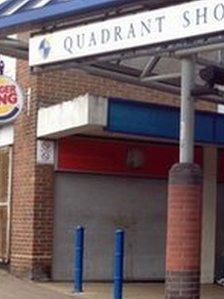The battle to revitalise shopping centres
- Published

One-in-five shopping centres could be at risk of going into administration
"I drove by the Quadrant Centre 25 years ago when I came to Dunstable. And guess what - it looked exactly the same then as it does now, apart from the fact that it has fewer shops."
Councillor Nigel Young doesn't hold back when it comes to his local shopping centre.
"It's awful. A large part of it needs to be knocked down and it's crying out for investment."
Around a third of the shops stand empty. Jeweller HS Samuel was the latest retailer to leave in the last few weeks, its shutters now permanently down.
But Dunstable's high street is actually doing a lot better these days and is starting to thrive.
It's the 1960s-style shopping centre which is now holding back the whole regeneration of the town.
For many months, Central Bedforshire Council has been trying to secure a deal with the owner. But councillor Young says every offer has either been refused or rejected.
"It's incredibly frustrating," says councillor Young, Executive Member for Regeneration.
"We've put together a £13m package to rebuild and revitalise this area. And we're caught in the crossfire, and it's allowing our town to collapse."
The trouble is that the Quadrant Shopping Centre isn't worth nearly as much as it once was. And it's a problem facing an awful lot of other shopping centres in weaker towns, too.
Financial crash
In the boom times, shopping centres were very popular with investors, changing hands frequently and usually bought with large amounts of debt.
They were seen as a safe bet when property prices kept on going up. But after the financial crash, commercial property prices tumbled.
Take the Quadrant Shopping Centre. Officials tell me that five years ago an offer was tabled for just under £50m. Today, its valuation is less than a quarter of that.
According to research for the British Council of Shopping Centres (BCSC), one in every five shopping centres across the UK is in breach of its loan agreements and therefore potentially at risk of administration.
It amounts to more than £10bn worth of real estate.
In many instances it means that the lenders, more often than not the banks, are now the effective owners.
And a stalemate has developed.
"The lender has lost a lot of money on that investment. They're unwilling, in many cases, to throw good money after bad," says Ed Cooke, the BSCS's director of policy.
"Equally they're unwilling to sell and crystallise their loss that they've made. Essentially this puts us at an economic impasse so investment isn't going into these shopping centres. And shopping centres are businesses that require constant investment," Mr Cooke said.
Now an industry-wide taskforce is being launched to try to identify the true scale of the problem and the towns affected, as well as come up with some solutions.
The government asked for the taskforce to be set up in its response to Mary Portas's review of the High Street.
'Social responsibility'

Councillor Nigel Young says part of the shopping centre should be knocked down
"Empty or dilapidated property is a visible symptom of the struggle town centres are facing. The underlying problems are complex and the challenges in tackling these issues are significant, " says Mark Williams, the Chair of the Distressed Retail Property Taskforce.
But by dint of their size, failing shopping centres are the biggest challenge and Mark Williams says doing nothing is no longer an option:
"People who invest and own town centres have a dual responsibility - to the investor who's providing the money and to the wider community. So there's a social responsibility as well as a financial one. Shopping centres are the heartbeat of a town, " he says.
You can see the effects in Dunstable. There's a lot riding on the fate of the Quadrant.
"We have the money... I think you can see how frustrated we are. We just need people to start listening to us," says councillor Young.
The Quadrant is owned by Glanmore Property Fund, a private investment fund. It declined to comment. Royal Bank of Scotland confirmed it is a lender to Glanmore, but said it had no involvement in managing the fund.
As this case shows, the new taskforce won't have an easy task in breaking the stalemate of distressed retail property.